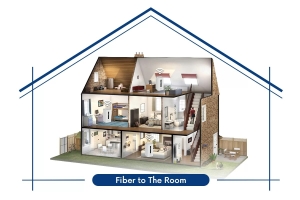A robust internet infrastructure is crucial in a world where connectivity drives productivity and entertainment. Enter Fiber to the Room (FTTR) technology—a game-changer in accessing high-speed internet within our homes and offices. FTTR takes fiber-optic connections to individual rooms, ensuring consistent and reliable performance throughout your space.
But what makes this technology even more compelling? Integrating a 10GE LAN port alongside XGS-PON Single-Family Unit (SFU) capabilities enhances network efficiency. This powerful combination supports ultra-fast data transmission and elevates user experiences across various applications—whether you’re streaming 4K videos, engaging in online gaming, or conducting business meetings.
Are you curious about how FTTR, with these advanced components, can transform your digital landscape? Let’s explore the intricacies of this cutting-edge technology and uncover its numerous benefits!
What is a 10GE LAN Port, and what are its benefits to FTTR Systems?
A 10GE LAN port, or 10 Gigabit Ethernet local area network port, is a high-speed interface designed for modern networking needs. It offers significantly faster data transfer rates compared to traditional Ethernet ports. This capability makes it ideal for bandwidth-intensive applications.
In Fiber to the Room (FTTR) systems, integrating a 10GE LAN port enhances overall performance. With higher throughput, users experience seamless streaming and gaming without lag. Multiple devices can connect simultaneously while maintaining optimal speeds.
Additionally, the low latency provided by a 10GE connection allows for quicker response times in online activities. This proves essential in offices or smart homes where many devices rely on continuous internet access.
Moreover, these advanced ports make scalability easier. As demands grow, upgrading networks to accommodate more users or devices is straightforward and efficient.
Advantages of Using FTTR with 10GE LAN Port and XGS-PON SFU
Fiber to the Room (FTTR) technology brings remarkable advantages, especially when combined with a 10GE LAN port and XGS-PON SFU. This combination ensures ultra-fast data transfer rates, making it ideal for high-demand environments like offices or smart homes.
The 10GE LAN port facilitates seamless connectivity between devices. This means faster downloads and less buffering during streaming, and users experience smooth online gaming sessions without interruptions.
XGS-PON SFU enhances this setup by providing superior bandwidth efficiency. It supports multiple users without sacrificing speed, ensuring everyone stays connected reliably. The result is an optimized network that caters to various needs simultaneously.
Moreover, FTTR reduces latency significantly compared to traditional systems. Quick response times are crucial for applications such as video conferencing or real-time collaboration tools. With this advanced infrastructure, you can expect enhanced productivity across your digital landscape.
Improved Performance with High-Speed Connectivity
High-speed connectivity is revolutionizing how we experience internet services. With FTTR technology, data travels faster than ever from the central hub to each room in your home or office.
The integration of a 10GE LAN port amplifies this performance. It allows lightning-fast data transfer rates, minimizing latency and improving overall efficiency. This means smoother streaming, quicker downloads, and uninterrupted video calls.
Moreover, XGS-PON SFU is crucial in enhancing that speed across multiple devices. Users can connect numerous gadgets without worrying about bandwidth limitations.
This seamless connection not only boosts productivity but also elevates user experiences significantly. Whether gaming online or working remotely, high-speed connectivity ensures optimal performance.
How to Implement FTTR with 10GE LAN Port and XGS-PON SFU in Your Network
Implementing FTTR with a 10GE LAN port and XGS-PON SFU requires careful planning. Start by assessing your network needs. Identify the areas where connectivity is crucial.
Next, choose the right equipment. Ensure that your switches support 10GE connections. Opt for an XGS-PON SFU that can handle high bandwidth demands.
After acquiring the necessary hardware, strategically lay down fiber optic cables throughout your premises. This step maximizes efficiency in reaching every room.
Configure your network settings to enable seamless device integration. Use VLANs to manage traffic effectively and prioritize critical applications.
Conduct thorough testing post-installation to verify performance metrics. Monitoring tools will help track data speeds and identify potential issues early on.

Global Fiber Optics Market Size Forecast 2022-2032 by type
The Global Fiber Optics Market is poised for substantial growth between 2022 and 2032, driven by the increasing demand for high-speed data transmission and the proliferation of advanced communication technologies. Within this vibrant market, “Multimode Fiber Optics” and “Single-Mode Fiber Optics” stand out as pivotal segments. Multimode fiber optics are primarily favored in short-distance applications due to their ability to carry multiple light modes simultaneously, making them ideal for data centers and local area networks where bandwidth capacity is essential, yet cost-effectiveness must be considered.
In contrast, Single-mode fiber optics shine in long-distance communications; with a smaller core that allows only one mode of light to propagate, they boast reduced signal attenuation over extensive distances and higher overall performance efficiency. As industries continue to integrate next-generation broadband solutions and intelligent technologies into their infrastructure, the dynamics between these two types will significantly shape the landscape of optical networking globally through cutting-edge innovations designed for resilience in an ever-evolving digital ecosystem.
Conclusion
The integration of FTTR technology with a 10GE LAN port and XGS-PON SFU marks a significant advancement in network performance. Enhanced connectivity supports the growing demand for bandwidth and ensures low latency, making it ideal for both residential and commercial environments.
Organizations looking to future-proof their networks can benefit immensely from this setup. With high-speed capabilities, users can enjoy uninterrupted streaming, seamless gaming experiences, and efficient remote work solutions. The ease of implementation further adds to its appeal, allowing businesses and homes to upgrade their infrastructure without significant disruptions.
You are embracing FTTR with these advanced components, which positions you at the forefront of technological advancements in networking. Investing in such robust systems today prepares you for tomorrow’s challenges while enjoying superior connectivity now.





